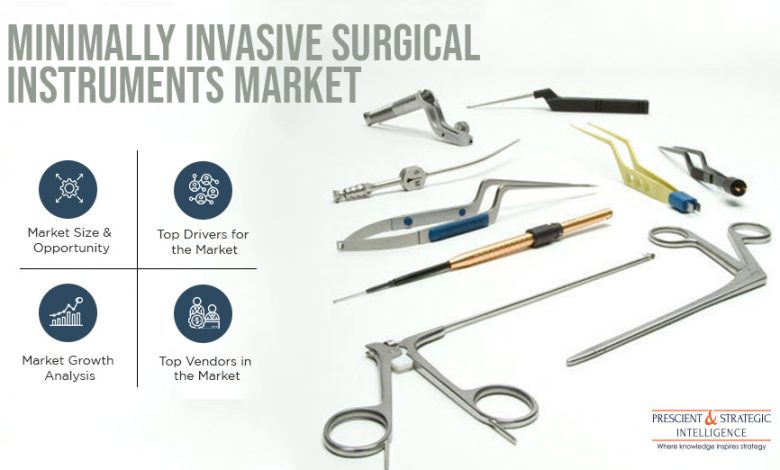How is Expanding Medical Tourism Industry Driving Minimally Invasive Surgical Instruments Market?

Minimally Invasive Surgical Instruments Market Overview
With the rising incidence of chronic diseases, such as cardiovascular diseases, diabetes, and cancer. Mushrooming population of geriatric people. The requirement for minimally invasive surgical instruments is rising sharply across the world. According to the World Health Organization (WHO), cardiovascular diseases (CVDs) are majorly responsible for deaths all over the world and claim around 17.9 million lives every year. Furthermore, the organization reported that 9.6 million across the world lost their lives because of cancer in 2018.
Diabetes is another highly prevalent chronic disease. The WHO reports that 422 million live with diabetes globally. With the increasing occurrence rate of these diseases and rising healthcare costs. The healthcare burden on people is soaring. Which is making the governments of several countries increase their healthcare expenditure. As per the World Bank, the worldwide healthcare expenditure surged from 8.5% of the gross domestic product (GDP) in 1996 to 9.8% of the GDP in 2014. The rising spending on healthcare is expected to propel the sales of medical devices, such as minimally invasive surgical instruments.
Market Size
Besides the aforementioned factors, the surging population of geriatric people is also driving the global minimally invasive surgical instruments market. According to the World Population Ageing 2020 report published by the United Nations Department of Economic and Social Affairs (UNDESA), the population of people aged 65 years or above will rise from 727 million in 2020 to more than 1.5 billion by 2050. As older people are vulnerable to various diseases, their ballooning population is positively impacting the worldwide demand for these instruments.
Owing to the above-mentioned factors, the value of the minimally invasive surgical instruments market is expected to rise from $28.7 billion in 2016 to $53.1 billion by 2023, exhibiting a CAGR of 9.3% between 2017 and 2023. Depending on product, the market is classified into electrosurgical instruments, inflation systems, guiding devices, and handheld instruments. Out of these, the handheld instruments category dominated the market in the years gone by, as these instruments reduce the strain on fingers, which assists healthcare practitioners during surgeries.
Industry Share
The major application areas of these instruments are urology, ophthalmology, obstetrics and gynecology, cardiovascular, laparoscopy, orthopedic surgery, neurosurgery, and cosmetic surgeries. Amongst these, the requirement for these instruments was the highest in laparoscopy applications during the last few years, as per the observations of the market research company, P&S Intelligence. This was because of the high incidence of obesity and soaring adoption of laparoscopy for bariatric or weight reduction surgeries.
Geographically, the Asia-Pacific (APAC) region is predicted to be the fastest-growing region in the minimally invasive surgical instruments market in the coming years. This is credited to the soaring population of patients suffering from various chronic illnesses, ballooning geriatric population, surging per capita income of people, and improving healthcare infrastructure and facilities in the region. As per the United Nations Economic and Social Commission for Asia and the Pacific (UNESCAP), the population of people aged 65 years and above constituted around 11.4% of the population in 2013, and this share will rise by around 20% by 2050.
Trends Insights
Thus, the surging incidence of chronic diseases, increasing healthcare expenditure of several countries, and mushrooming population of older people will drive the demand for minimally invasive surgical instruments in the coming years.
As per a report by P&S Intelligence, the global minimally invasive surgical instruments market is predicted to reach a value of $53.1 billion in 2023, increasing from $28.7 billion in 2016, and is projected to progress at a 9.3% CAGR during the forecast period (2017–2023).
The market is growing due to the rising prevalence of chronic diseases, increasing geriatric population, surging requirement for minimally invasive surgeries, and rising government healthcare expenditure across the globe.
In terms of product, the minimally invasive surgical instruments market is divided into inflation systems, handheld instruments, guiding devices, and electrosurgical instruments. Out of these, the handheld instruments category accounted for a major share of 36.4% in 2016, owing to the fact that these devices lead to reduced strain on fingers when operative procedures are going on. Because of this, the adoption of minimally invasive handheld instruments is growing amongst surgeons across the globe. Handheld instruments include spatulas, graspers, sutures, forceps, retractors, and dilators.
Minimally Invasive Surgical Instruments Market Opportunities
On the basis of application, the minimally invasive surgical instruments market is categorized into urology, laparoscopy. Neurosurgery, cardiovascular, ophthalmology, cosmetic surgery, obstetrics and gynecology, and orthopedic surgery. The laparoscopy division dominated the market in the past and is predicted to account for a 25.1% share of the market by 2023. The surging prevalence of obesity and the rising using usage of laparoscopy for weight reduction surgeries is resulting in the growth of the category. The cardiovascular division is predicted to register the fastest growth during the forecast period.
Geographically, the market was led by North America in the past because of the rising prevalence of chronic diseases. Increasing geriatric population, enhanced healthcare infrastructure. Growing number of surgical procedures. The Asia-Pacific region is expected to progress at the fastest pace during the forecast period because of the rising number of patients suffering from chronic diseases. In addition to this, the growing per capita income and developing healthcare facilities are also contributing to the growth of the regional domain.
Minimally Invasive Surgical Instruments Market Strategy
The rising healthcare expenditure is a major driving factor of the minimally invasive surgical instruments market. As per the World Bank, the worldwide healthcare expenditure rose to 9.8% GDP in 2014. In addition to this, the current growing economic condition of several countries is further lead to a rise in the health expenditure. The facilities and infrastructure in medical facilities will improve, owing to this. This is predicted to lead to the growth of the market in the years to come.
A key trend being witnessed in the minimally invasive surgical instruments market is the expansion of the medical tourism industry. The industry is particularly growing in developing countries, such as Mexico, Brazil, Malaysia, China, South Korea, Malaysia, and India, where the rising number of surgical procedures are projected to offer a number of opportunities to the players operating in the domain. People from developed go for medical procedures in these countries as they provide high-quality care at lower costs.
Hence, the market is witnessing growth due to the rising healthcare expenditure and expanding medical tourism industry





